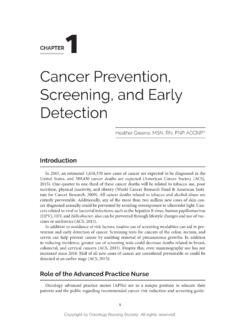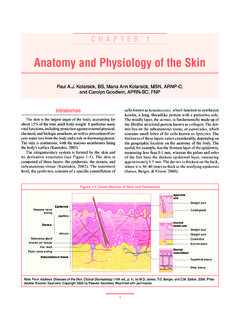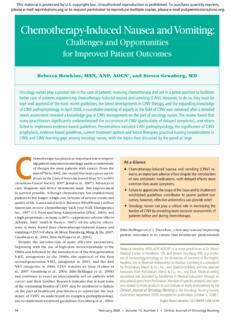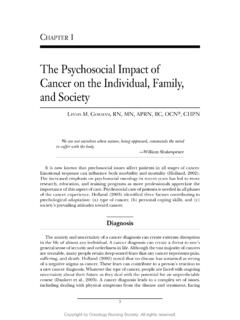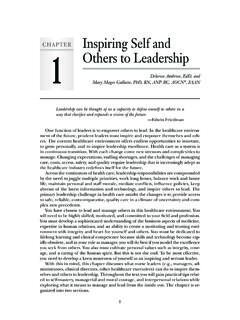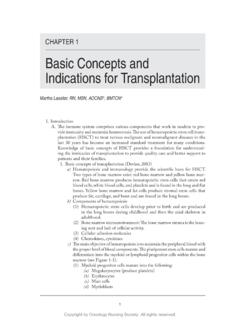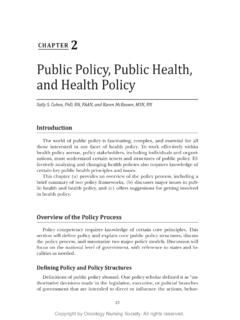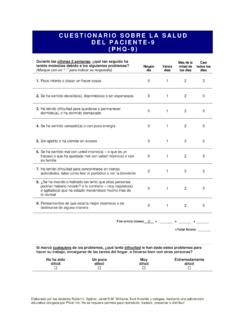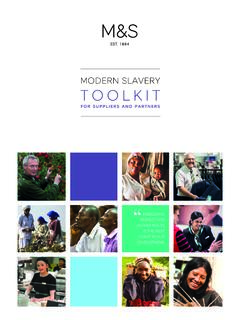Transcription of Oral Adherence Toolkit - ONS
1 oral Adherence Toolkit Tool 1. Patient Assessment Checklist Tool 2. Patient Education Tool 3. oral Chemotherapy Ordering Standards Tool 4. Pharmacy Descriptions, Benefits, and Concerns Tool 5. Reimbursement and Patient Assistance Resources Tool 6. Food, Drug and Pathway Interactions and Effects Tool 7. Sample Treatment Calendars Tool 8. Factors Influencing Adherence Tool 9. Methods Used to Encourage Patient Adherence Tool 10. Traditional Counseling Versus Motivational Interviewing Tool 11. Medication Reconciliation Tool 12. Developing a Process of Medication Tracking Tool 13. Readiness to Change Scale Patient and Provider Resource List TOOL 1 Patient Assessment Checklist Before beginning an oral chemotherapy regimen, the patient should be assessed for the ability to obtain and administer the regimen according to the treatment plan based on some of the following merits: Socioeconomic issues How will the patient fill the prescription? Does the patient have insurance? What copays and out-of-pocket costs are associated with the patient's insurance?
2 Psychosocial issues What is the patient's mental status? Does the patient have social support? Regulatory or administrative needs Is the drug on formulary? Is the drug approved by the FDA? Health and medication beliefs and preferences Is the patient ready to accept the necessity of treatment? Is the patient prepared for safety and Adherence concerns? Have the patient's expectations about treatment been managed? Lifestyle Where does the patient live in proximity to the clinic/pharmacy? Is the treatment regimen a good fit for the patient's lifestyle ( , does the patient work, drive, etc)? Will a family member or caregiver be available to help with treatment and patient care? Personal factors How does the patient learn best? Does the patient have any cognitive impairment? Does the patient have the ability to take medications as prescribed ( , swallow pills or open packaging)? Does the patient have comorbidities that could impact or affect the treatment regimen or Adherence ? Does the patient use alcohol or drugs?
3 Treatment factors How complex is the patient's treatment regimen? Is there pill burden associated with the treatment regimen? What is the treatment duration? SOURCES: Irwin M, Johnson LA (2015). Factors influencing oral Adherence : Qualitative metasummary and triangulation with quantitative evidence. Clin J Oncol Nurs, 19(3 suppl):6 30. Neuss MN, Polovich M, McNiff K, et al (2013). 2013 Updated American Society of Clinical Oncology/Oncology Nursing Society chemotherapy administration safety standards including standards for the safe administration and management of oral chemotherapy. Oncology Nursing Forum, 40(3):225 233. TOOL 2 Patient Education Once a comprehensive patient assessment is completed and the treatment plan developed, patients should be provided with verbal and written or electronic information that highlights important drug and safety information. The following should be included in the educational materials: 1. Diagnosis, goal and duration of treatment 2. Drug name 3.
4 Drug information, such as appearance and packaging 4. How the drug will be obtained 5. Potential side effects and the management of short- and long- term side effects, including reproductive and fertility risks 6. Safe storage and handling 7. Disposal of unused medication 8. Safe handling of body secretions and waste in the home 9. Dose schedule for the oral chemotherapy, as well as schedule of supplemental medications needed for the therapy 10. Food and/or drug interactions 11. Missed dose plan ( , what to do if the patient omits a dose). 12. Monitoring appointments ( , physician visits and any laboratory work needed). 13. Information on how, when, who and why to contact to report side effects and ask questions 14. The refill process, including how much time is needed to obtain refills and how to obtain them 15. A calendar with the patient's treatment cycle clearly written out, which should be given to the patient at the initial teaching session and reviewed at each follow-up session SOURCES: Bettencourt, E (2014).
5 oral chemotherapy: what your patients need to know. Oncology Issues, the Journal of the Association of Community Cancer Centers, 44 51. Neuss MN, Polovich M, McNiff K, et al (2013). 2013 Updated American Society of Clinical Oncology/Oncology Nursing Society chemotherapy administration safety standards including standards for the safe administration and management of oral chemotherapy. Oncology Nursing Forum, 40(3):225 233. TOOL 3 oral Chemotherapy Ordering Standards A standardized process of verification is recommended with all chemotherapy orders. Include the following in oral chemotherapy prescriptions: Patient name and second identifier Date of order Name of drug (complete generic name). Allergies Method of dose calculation Dosage Route of administration Schedule and frequency of administration Treatment duration and time limitation Dispensing quantity Duration of therapy and number of days of treatment, if medication is not to be taken continuously Number of refills, including if there are no further refills Time limitation to ensure appropriate evaluation at predetermined intervals SOURCES: Neuss MN, Polovich M, McNiff K, et al (2013).
6 2013 Updated American Society of Clinical Oncology/Oncology Nursing Society chemotherapy administration safety standards including standards for the safe administration and management of oral chemotherapy. Oncology Nursing Forum, 40(3):225 233. Polovich M, Olsen M, LeFebvre KB (2014). Chemotherapy and Biotherapy Guidelines and Recommendations for Practice. Pittsburgh, PA: Oncology Nursing Society. TOOL 4 Pharmacy Descriptions, Benefits and Concerns Filling prescriptions for oral cancer therapies can be challenging, as pharmacies must have designated areas to store and compound drugs and separate tools to count and dispense the drugs. In addition, insurance companies may require the use of other pharma- cies, including mail-order pharmacies, which often provide a 30-day supply of the drugs at a lower cost but delay delivery. Some centers have begun on-site dispensing as a solution to this issue. An overview of different types of pharmacies is provided below. Dispensing Site Benefits Concerns Community Often located near patient's residence Community pharmacist may not have adequate experience to retail provide counseling for specialized medications May be better positioned to monitor for pharmacy drug drug interactions if all prescriptions May not stock less frequently used or high-cost medications, thus are filled at this pharmacy chain resulting in delay in starting cycle Billing concerns may not bill correctly when medication is covered under Medicare Part B.
7 Limited resources for patients without insurance or with high copays Specialty Has highly experienced and knowledgeable May not be local patient may have concerns about working with pharmacy oncology pharmacy staff pharmacy by phone Provides additional patient education by Education and instructions received may differ from information phone or mail received from provider, creating patient confusion Delivers medication to patient at no addi- Non-chemotherapy prescriptions may be filled at other locations, tional cost creating confusion with drug drug or food drug interactions Able to custom pack multi-strength doses to avoid multiple copays Works closely with insurance plans and Medicare Access to patient assistance programs Mail-order Usually decreased patient copay when med- Unlikely that patient will speak directly with an oncology phar- pharmacy ication is ordered in 90-day amounts macist May have nurse case managers on staff to Nurse case manager may not be an oncology nurse assist patients on medications for cata- Most require minimum 90-day supply strophic diseases.
8 Practice or Conveniently located inside oncology office Varying levels of physician supervision may be required, depending physician on regulations Has physician or nurse available for questions dispensing Drug safety rules mandated by HFAP, Joint Commission, OSHA. pharmacy Has all personnel available so that double . and public health rules require additional documentation and check of prescription can be performed for record keeping safety Has patient medical record readily available for questions Hospital May give patient access to an oncology Travel burden hospital pharmacy may not be located on same Pharmacy pharmacist campus as office Allows close communication with practice May not have access to patient assistance program information physician or nurse May limit to 30-day supply Generally follows double check of prescrip- tion if given patient data May be connected to practice through elec- tronic ordering system Dispenses investigational drugs HFAP: Healthcare Facilities Accreditation Program [American Osteopathic Association]; OSHA: Occupational Safety and Health Administration.
9 Based on information from Reff, MJ (2014). Physician dispensing adding value to patients and the practice. Oncology Issues, the Journal of the Association of Community Cancer Centers, 38 43. Retrieved from Weingart SN, Brown E, Bach PB, et al (2008). NCCN Task Force Report: oral Chemotherapy. Journal of the National Comprehensive Cancer Network, 6(suppl. 3):S-8-10. TOOL 5 Reimbursement and Patient Assistance Resources Medication cost can be a barrier to Adherence . Prior to starting an oral chemotherapy regimen, determine the cost to the patient. Most manufacturers offer financial assistance or reimbursement programs. To locate these programs online, do an internet search of the drug manufacturer with the words financial assistance or patient assistance to learn about that company's program. In addition, many foundations, including those listed here, provide patient assistance. CancerCare Co-Payment Assistance Foundation Cancer Supportive Care Programs National and International Listing of Pharmaceutical Programs good Days from Chronic Disease Fund HealthWell Foundation The Leukemia & Lymphoma Society's Co-Pay Assistance Program National Cancer Institute support and resources National Organization of Rare Disorders NeedyMeds Partnership for Prescription Assistance Patient Access Network Foundation Patient Advocate Foundation Patient Advocate Foundation's Co-Pay Relief program PSI Patient Services Inc.
10 1-800-366-7741. TOOL 6 Food, Drug and Pathway Interactions and Effects It is important to review your patient's regimen prior to the start of treatment. Understanding specific administration concerns, food and drug interactions and treatment side effects will help you guide patients and manage expectations. Consult the drug manufactur- er's product information, as well as print and online drug resources for guidance on the administration of each drug. Below are general interactions that are important to know and share with your patient depending on the treatment regimen, followed by websites that provide drug information for both patients and healthcare professionals. Food Drug Interactions It is generally recommended that oral agents be taken whole ( , do not crush or chew), though several drugs may be dispersed in water or juice until dissolved completely. Foods and activities that may impact absorption of chemotherapy can include: High-fat meals Alcohol Calcium or dairy products Lack of adequate fluid intake Caffeine Seville oranges Smoking Grapefruit juice Tyramine-rich foods ( , wine, yogurt, bananas, aged cheeses).
